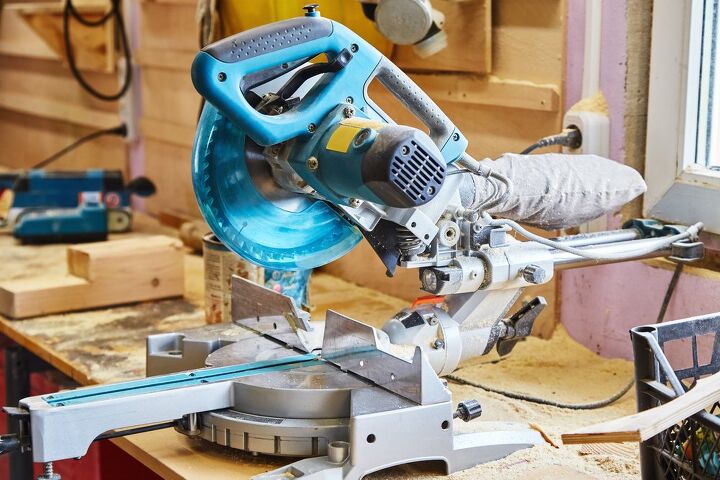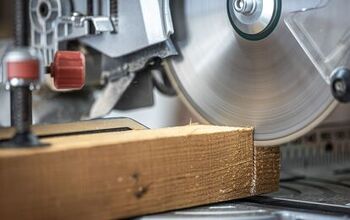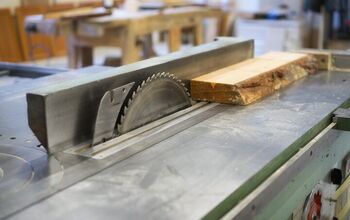10 in Vs. 12 in Miter Saw: What Are The Major Differences?

Once you are ready to use a power saw to cut through plywood, it is safe to say you have graduated from someone who enjoys DIY projects and turned into a bona fide home improvement enthusiast. Now that you are comfortable using more advanced tools and are embarking on more projects, you are also ready to bulk up your tool arsenal. This means you are most likely looking to purchase a miter saw. But should you buy the 10-inch or the 12-inch saw?
10-inch miter saws are more transportable and cut more precise edges than 12-inch saws, as the blade moves quickly and wobbles very little. The 10-inch saws are also more affordable with more models to choose from. 12-inch saws are costly, but they have much more power and higher durability. These saws are great for professionals looking to easily cut through thick wood and molding.
If you are looking to work on more projects that involve cutting wood and molding, a miter saw is an essential addition to your cutting arsenal. These saws come in a variety of blade sizes, ranging from as small as 7.5 inches all the way to above 20 inches. The two most common miter saw sizes are the 10-inch and 12-inch saws. For this reason, this article will focus on the benefits and disadvantages of these two most popular miter saw sizes. This will help you determine which size saw is perfect for your own needs.
10-Inch vs. 12-Inch Miter Saws
In general, miter saws are known for having smaller blades than many other types of saws. This is a huge benefit, as it makes them more transportable, and often a bit more user-friendly.
You might wonder, if miter saws range so much in length, if there is really that much of a difference between a 10-inch saw and a 12-inch saw. After all, it is only a two inch difference. The answer is, that while there is only a slight increase in size, there are significant differences in these two saws in how they perform, and what projects they are best suited for.
10-inch Miter Saws
10-inch miter saws are overwhelmingly the most common type of miter saw. The reason for this popularity is this blade can easily cut wood that is fairly thick, and can do so with precision. In fact, a 10-inch miter saw can comfortably cut wood that is up to 5 inches wide. This means you can easily cut most plywood and wood trim, making it a very common saw for those looking to handle most home improvement wood projects.
These saws have lots of perks, but they are not altogether perfect. After all, if they were, there would be no need for other sizes, like the 12-inch miter saw. So before you run out and buy a 10-inch miter saw, you should also know their drawbacks.
Advantages of 10-Inch Miter Saws
Versatile For Many Project Types
These saws are more popular than 12-inch saws, which means there are all sorts of blades to choose from. If you need to make an adjustment to your 10-inch miter saw for a particular project, the odds are you will be able to find the accessories you need for the 10-inch saw much easier than the 12 inches.
The Saw Has A Faster Spin
Because the blade is smaller, the 10-inch saw has a fast spin. This is critical for those looking for very exact cuts. If you need precise angular cuts, a 10-inch blade is definitely able to perform. The fast spin and smaller blade also means less wobble. This allows you more control, which adds further precision to your cuts.
Lower Energy Consumption
10-inch blades are built more for speed than power, especially compared to a 12-inch blade. This means the saws require and use much less energy than the 12-inch blade. They also exude less force, which makes them less intimidating, especially for those not all that comfortable holding a miter saw.
Affordable and Cost Effective
10-inch miter saws are more cost effective. They are not as large and powerful, which helps cut down on those costs, but they are also more common. You can choose from many brands and models. The odds are you can find what you are looking for on sale if you time your purchase right.
Drawbacks to 10 Inch Miter Saws
Cutting Constraints
The most obvious drawback to the 10-inch miter saw is its cutting constraints. While most of these saws can comfortably cut wood that is 5 to 6 inches wide, going beyond that is not possible. If you are going to have to cut more than your standard-sized plywood, you might want to think twice before purchasing the 10-inch saw.
Not Always As Durable
While you can certainly buy a quality and durable 10-inch wider saw, they normally do not hold up as strongly as a 12-inch saw. This is because 12-inch saws are built for tougher projects, so they have more lasting parts.
Less Powerful
The 10-inch saw is very fast, that’s for sure. But it does not back the same punch as a 12-inch miter saw. If you need a very powerful miter saw for your projects, be aware that the 10-inch saws are normally not the most powerful.
12-Inch Miter Saws
Although the 12-inch miter saw uses a similar concept and design and is only two inches in difference, it is a completely different beast altogether. These saws are built for power. A 12-inch miter saw can cut through thick wood with ease. These saws are built for power and built to last.
These saws are popular with carpenters who do large wood projects regularly. Deck building and other wood building is more often done with a 12-inch miter saw, for example. If you are looking for a larger blade and power, you might think the 12-inch miter saw is the one for you. Make sure you understand both the pros and cons, however, before you make your purchase.
Advantages to 12-Inch Miter Saws
Stronger Motor
12-inch saws have a stronger motor, which means more power. Power means you can cut through all sorts of materials with confidence. These motors might require more power, but they leave you with a piece of mind knowing they can handle tough tasks.
Cuts Larger And Heavier Pieces
12-inch blades can cut larger and heavier pieces than a 10-inch miter saw. Thanks to the size of the blade and the power of the machine, these saws can tackle much denser materials, and wood that is too wide for the 10 inch blade.
These saws are also great at cutting tougher and more dense crown molding. If this is something you plan on doing frequently, it is worth noting.
Built To Last
Perhaps most importantly, 12-inch miter saws are built to last. These are more professional saws, so the materials and craftsmanship is on a higher and more professional level. Purchasing a 12-inch miter saw is more expensive, but it is an investment that pays off if you plan to use it often.
Drawbacks to 12-Inch Miter Saws
More Expensive
12-inch miter saws are more expensive than 10-inch saws. They are not as common, which means there is less brand competition. Also, because they are built to last and made for professionals, they are simply priced higher.
Uses More Energy
Not only are these saws more expensive, but they use more energy. They might be more powerful, but that power comes at a cost. If you do not need the extra power of the 12-inch saw, you may want to go with the 10-inch saw. They consume less energy and are cheaper.
Bulkier
While these saws are durable, they are tougher to carry around. The 10-inch saw is a good option for transport, but the 12-inch saw is more for professionals to transport, and should not be the first option for beginners.
Less Precise
While 12-inch saws pack lots of power, they are not as precise as the 10-inch saw. They are not as fast and they are not designed to make the exact cuts like the 10-inch blade. If you are looking for exact cuts rather than large cuts, you might want to look for a different size miter saw.
Concluding Arguments on 10-inch vs. 12-inch Miter Saws
When you are trying to decide between a 10-inch versus a 12-inch miter saw, you need to understand what you need your saw to accomplish. The 10-inch miter saw is incredibly versatile. This makes it a great choice for many who are looking for a transportable saw that can cut wood up to 5 inches thick. 10-inch saws are also fast moving, allowing you to make very precise cuts.
10-inch saws cannot cut thicker than 6 inches. They also do not have as much durability and power as a 12-inch miter saw. A 12-inch miter saw is a great option for those looking to make stronger cuts, or for someone who needs a miter saw with more power than a 10-inch saw can provide. 12-inch miter saws are bulkier and expensive.

Tom Gaffey is an expert writer who currently resides in Washington D.C. Tom has a passion for real estate and home improvement writing, as well as travel and lifestyle writing. He lived the last twelve years in Hawaii where he worked closely with luxury resorts and event planners, mastering his knowledge of aesthetics and luxury products. This is where he found his passion for home improvement and a keen interest in DIY projects. Currently, Tom resides in Washington D.C, and also working on his debut fiction novel.
More by Tom Gaffey



























